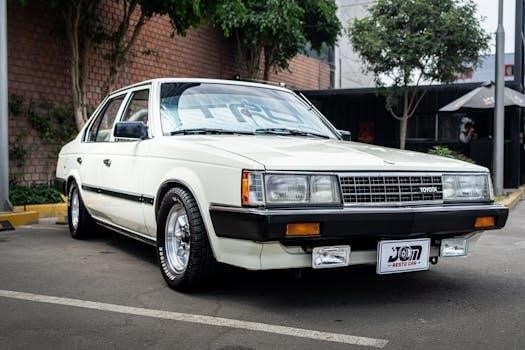The Toyota 4Runner, an iconic SUV, has evolved over generations. Notably, earlier models offered manual transmissions. However, newer 4Runners now feature automatic transmissions. This shift reflects changing consumer preferences.

Toyota 4Runner Manual Transmission⁚ An Overview
The Toyota 4Runner, a long-standing SUV in Toyota’s lineup, has a history of offering various transmission choices. Initially, manual transmissions were available, providing drivers with a more engaging driving experience. Over time, automatic transmissions became more prevalent. The current 4Runner models primarily feature an 8-speed automatic transmission as the standard option. This shift reflects broader trends in the automotive industry, where automatic transmissions have gained popularity due to their convenience and improved fuel efficiency. While manual transmissions are no longer offered in the 4Runner, they remain a part of its heritage.
Manual Transmission Availability in Different 4Runner Generations
Manual transmissions were offered in earlier 4Runner generations; The third generation was the last to offer this option. Later generations shifted to automatic transmissions due to market demand.
Third Generation 4Runner⁚ The Last with a Manual Option
The third-generation Toyota 4Runner marked the end of an era for manual transmission enthusiasts. This generation, which spanned from 1996 to 2002, was the last to offer a manual gearbox as an option. After this, Toyota discontinued the manual option, focusing on automatic transmissions for subsequent models. This decision reflected broader trends in the automotive market. The availability of a manual transmission provided a more engaging driving experience.
The third-generation models equipped with manuals are now sought after by those who prefer a more hands-on approach. These models offer a unique blend of ruggedness and control that is unavailable in newer, automatic-only 4Runners.
Reasons for Discontinuation of Manual Transmissions
Toyota discontinued manual transmissions in the 4Runner due to a lack of consumer demand. The take rate for manual options was minimal, making it unsustainable for Toyota to continue offering them.
Lack of Customer Interest in Manual Transmissions for 4Runner
The primary reason for the discontinuation of manual transmissions in the Toyota 4Runner is the dwindling customer interest. Consumer preferences have shifted towards automatic transmissions in SUVs. The demand for manual gearboxes in the 4Runner was demonstrably low. Toyota has stated that the take rate was too low to justify continued production and support. The lack of demand made it economically unfeasible to keep offering the option. Automatics offer convenience that many modern drivers prioritize. This trend has solidified the automatic transmission’s dominance in the 4Runner lineup.
Current 4Runner Transmission⁚ Automatic Focus
The modern Toyota 4Runner exclusively features an 8-speed automatic transmission. This is standard across SR5, TRD Sport, TRD Off-Road, and Limited trims. The automatic caters to current market demands and preferences.
Standard 8-Speed Automatic Transmission in Newer Models
The newer Toyota 4Runner models come standard with an 8-speed automatic transmission. This transmission is the only option available. It’s equipped in the SR5, TRD Sport, TRD Off-Road, and Limited trims. This focus on automatics reflects a shift in market demand. Manual transmissions have become less popular. Toyota cites a lack of customer interest as the primary reason. The automatic transmission provides smooth and efficient performance. It also enhances the vehicle’s overall driving experience. This decision aligns with industry trends. Many manufacturers are moving away from manual options. The 8-speed automatic ensures optimal fuel efficiency.

Manual Transmission in Related Toyota Models
The Toyota Tacoma stands out. It is the last Toyota pickup offering a manual transmission in America. This provides enthusiasts a choice. However, its take rate was only 2% in 2024.
Toyota Tacoma⁚ The Last Toyota Pickup with a Manual Option
While the 4Runner has moved away from manual transmissions, another Toyota model keeps the spirit alive. The Toyota Tacoma remains the last pickup in the American Toyota lineup to offer a manual gearbox. This appeals to drivers who prefer a more engaging driving experience and greater control over their vehicle.
Despite the dwindling demand for manual transmissions, Toyota continues to cater to this niche market with the Tacoma. The availability of a manual option sets the Tacoma apart from many of its competitors. It provides a unique selling point for those seeking a traditional driving experience in a modern truck. The 2024 take rate was only 2%.

Components and Diagrams for Manual Transmissions
The R150F transmission, found in some 4Runners, consists of gears, shafts, and other components. Diagrams detail the assembly. These resources are helpful for maintenance and repairs.
R150F Manual Transmission Parts and Schematics
The R150F manual transmission, commonly found in older 4Runner models, comprises over fifty individual components. These include gears, shafts, forks, and levers, all meticulously designed for optimal performance. Schematics and diagrams are essential for understanding the transmission’s internal workings. These resources aid in identifying parts, troubleshooting issues, and performing maintenance.
Components like the gear shift fork and lever shaft play crucial roles in gear selection. Detailed schematics provide a visual representation of the transmission’s assembly, assisting mechanics in repairs and rebuilds. Access to these diagrams is invaluable for those working on these older 4Runner models, ensuring accurate and efficient service.
Gear Ratios in Manual Transmission 4Runners
Original equipment manufacturer (OEM) gear ratios varied among 4Runner models with manual transmissions. Some models featured a 3.90 ratio. Checking the OEM ratio is crucial for maintaining performance and compatibility during repairs.
OEM Gear Ratios for Specific 4Runner Models with Manual Transmissions
Specific Toyota 4Runner models equipped with manual transmissions featured distinct OEM gear ratios. For instance, certain models had a 3.90 ratio. Identifying the correct OEM gear ratio is important. It ensures optimal performance. It also guarantees compatibility when replacing or repairing transmission components. Different 4Runner generations and configurations might utilize varying gear ratios. These ratios impact acceleration, fuel efficiency, and overall driving experience. Consulting original documentation or manufacturer specifications is essential. This confirms accurate gear ratio information for your 4Runner model. This is particularly true when undertaking transmission-related maintenance or modifications to your vehicle.
Manual Transmission Identification
Manual transmission models can be identified by their transmission code. This code provides information about the transmission type. This helps differentiate between various models and specifications for replacement or repair purposes.
Identifying Manual Transmission Models by Transmission Code
To accurately identify a 4Runner’s manual transmission, locate the transmission code. This code, often found on a sticker or plate on the transmission housing, reveals the specific model. For instance, the R150F is a common code for Toyota manual transmissions, as seen in component diagrams. Knowing the code helps when sourcing parts or performing maintenance. This ensures compatibility and avoids potential issues. Different codes may indicate variations in gear ratios or internal components. Consulting a Toyota service manual or online resources helps decode the transmission code. This crucial step ensures correct identification.

Aftermarket Support for Manual Transmissions
Owners of older 4Runners can still find aftermarket support. Parts and services remain available for manual transmissions. This helps maintain these classic vehicles.
Availability of Parts and Services for Older Manual Transmission 4Runners
Despite the discontinuation of manual transmissions in newer 4Runner models, a dedicated aftermarket exists to support owners of older vehicles. Finding parts and services for these classic manual transmissions is still possible. Numerous online retailers and specialized repair shops cater to the needs of enthusiasts who prefer the engaging driving experience offered by a manual gearbox. From replacement gears and clutch kits to complete transmission rebuilds, the aftermarket provides a range of options to keep these older 4Runners running smoothly. This ongoing support ensures that the legacy of manual transmission 4Runners continues.
Potential Future for Manual Transmissions in 4Runners
While the current 4Runner lacks a manual option, a future generation could see its return. Toyota may consider offering it, based on customer demand and market trends.
Considerations for a Manual Transmission in the Sixth-Generation 4Runner
The possibility of a manual transmission in the sixth-generation 4Runner hinges on several factors. Predominantly, customer interest plays a crucial role, as Toyota cites a lack of demand for manuals in the 4Runner. Market trends and competitor offerings are also key. The Toyota Tacoma, a related model, still offers a manual, suggesting Toyota hasn’t completely abandoned the option.
If sufficient demand arises or if Toyota aims to cater to enthusiast drivers, a manual transmission could reappear. However, this would likely require a significant shift in market preferences.
Comparison with Competitors
The Jeep Wrangler offers a manual transmission, contrasting with the 4Runner’s automatic-only approach. This difference caters to diverse driver preferences, with the Wrangler appealing to those seeking more control.
Jeep Wrangler vs. Toyota 4Runner⁚ Transmission Options
When comparing the Toyota 4Runner and Jeep Wrangler, a key difference lies in their transmission offerings. The current 4Runner exclusively features an automatic transmission. In contrast, the Jeep Wrangler still provides a manual transmission option, catering to enthusiasts who prefer greater control over their vehicle’s gears. This distinction highlights a divergence in design philosophy. The 4Runner prioritizes convenience, while the Wrangler aims to offer a more engaging driving experience. This choice reflects the Wrangler’s focus on off-road capabilities and driver involvement, setting it apart from the 4Runner in the transmission department.
